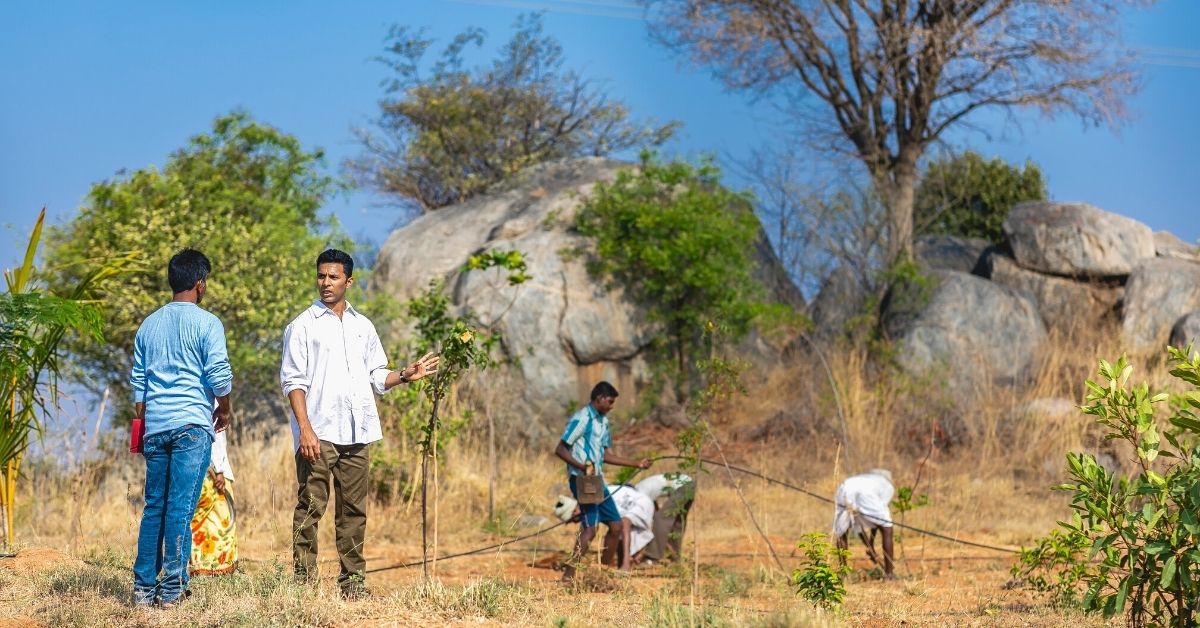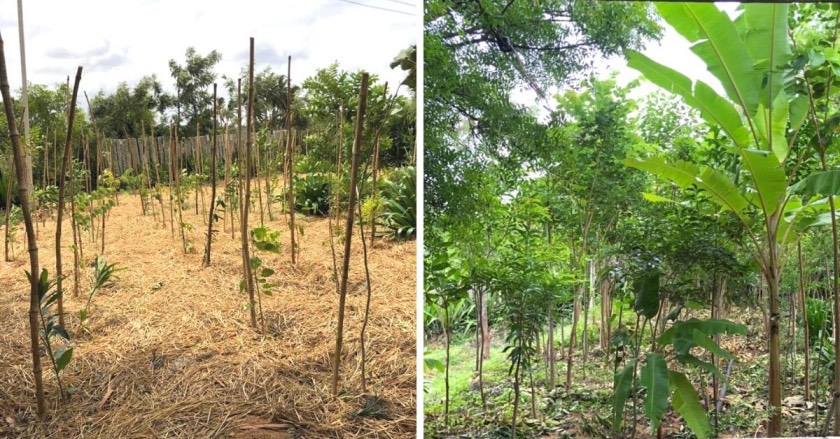A few years ago, were you to drive past the 100-acre land in Shoolarji, along the Tamil Nadu-Karnataka border, you might have found nothing but a barren patch that had long lost its fertility owing to overuse of chemicals.
But today, this land is a paradise that’s home to 40,000 trees of 250 varying species, as well as a variety of birds and other biodiversity. Named Vanantara, it is the labour of love of Varun Ravindra and 40-odd others who have brought about such a powerful transformation in a matter of five years.
Today, the fertile land has no trace of chemicals, and is instead evolving into a community forest that is self-sufficient to meet its basic needs.
Varun, who helmed this initiative, says he has been concerned about environmental degradation since his early childhood days. “I stopped eating chicken when I was 10 years old. I told my parents naively that if I eat the chicken, its relatives may keep searching for it and will never know where it went,” he says.
The 38-year-old says that even during his growing years, he was making environmentally conscious efforts to reduce the harm on the environment.

“One time, I read in a home improvement magazine that putting away the last remaining piece of bathing soap in a commode would keep the bathroom equipment clean. But further study made me realise that the chemicals in the soap would eventually kill the bacterial ecosystem in the sewage system. I eventually discarded the practice,” he recalls.
Varun says that in 1994, his father purchased land to farm, and started adopting cows and horses. “Because of this, I became closer to nature and developed an affection towards animals and the environment,” he says.
Following a road less travelled
Eventually, he graduated in 2009 as a chartered accountant and took a corporate job. Alongside, he was imparting free lessons in Math and English, and taking lessons in organic farming with NGOs.
Varun diverted from the professional corporate path to start organic farming. “I had only volunteering experience in agriculture, and wanted to learn more. So I went to experts and attended workshops. Gradually, I met farmers who practised organic farming and learned practically,” he says.
Varun spent the next four years learning organic farming. This made him realise the importance of soil and carbon sequestration, he says.
“Soil and plants have a massive capacity to arrest carbon, which is becoming an issue to contain in the environment. I realised that planting dense forests on a large piece of land would serve the purpose of mitigating the environmental crisis,” he explains.
Initially, Varun planned to take up government-owned land for plantation. But these lands faced threats of ill-maintenance and destruction if left unattended.

He then decided to rope in like-minded people through social media and NGOs, who could privately own the land to build a forest and protect the environment. “Becoming an owner brings accountability, and if like-minded people join hands, they can create and protect an ecosystem by co-existing with it,” he says.
Thus, in 2016, he conceived Vanantara with a few others and collectively bought 100 acres of land.
Varun says that it was difficult to convince people to become stakeholders of barren land. “The thought of converting barren land into a fertile, lush green forest seemed unimaginable. But as the changes became visible, more people joined,” he says.
The members of the initiative started with soil remediation and building an ecosystem for different plant species to thrive.
“The soil was treated with vermicompost and bio-fertilisers such as jeevamrut, a mix of Bengal gram, jaggery, cow urine and soil. Biomass and micro-organisms were introduced to enhance the soil quality. Cattle were introduced inside the campus, not for milking or slaughter, but to act as natural de-weeders by grazing on the grass and providing farm manure,” he adds.
As the land began showing signs of fertility, the members ended up planting over 40,000 trees. “The trees are planted by maintaining a distance of 10×10 feet. A drip irrigation network has been laid across the land to make efficient use of water.,” he says.
Siddharth Devaraj, a member at the community forest, says, “The forest has planted varieties such as the black board tree, honge, and neem, along with fruit varieties like jamun, mango, bananas, water apple, fig, coconut, and Indian jujube. The species have been thoughtfully planted to ensure nitrogen fixation and other nutrients are formed and support each other’s growth.”
Siddharth adds that over 70 species of birds have made the forest their home. “The best part is that the project does not involve intensive farming. The main purpose is to develop a forest and have stakeholders to preserve nature,” he adds.
An effort to reverse climate change
Varun hopes that creating the green oasis may inspire city dwellers to make a healthier switch and quit the urban lifestyles by following a quieter, environment-friendly life.
Another member, Kiran Shantakumar, says he is amazed by the transformation that has taken place over the years. “I am one of the initial members and found the concept intriguing. The land was barren, and it started taking shape from 2018, when the plants started taking grip in the soil and the fertility improved,” he says.
Kiran says that watching a barren land come to life has been a learning experience. “We had no experience in afforestation or gardening, and we’re proud to see the progress. The land can serve as a retreat from mundane urban life,” he adds.
Varun says, “The community forest also offers facilities like an animal farm, a kids’ play area, an open walking area and an outdoor gym. The place offers a safe and comfortable life with the experience of living with nature.”
He says that the community forest has also supported local farmers by creating employment opportunities. “Climate change has made agriculture erratic, and farmers often experience irregular harvest cycles. The organic farms and other livelihood alternatives serve as sustainable livelihood for the farmers,” he says.
Varun has also developed three Miyawaki forests by planting 40,000 trees across Bengaluru. “The initiative is my attempt to reverse the impacts of climate change. I hope many follow and become a part of the movement,” he adds.
Edited by Divya Sethu
No comments:
Post a Comment